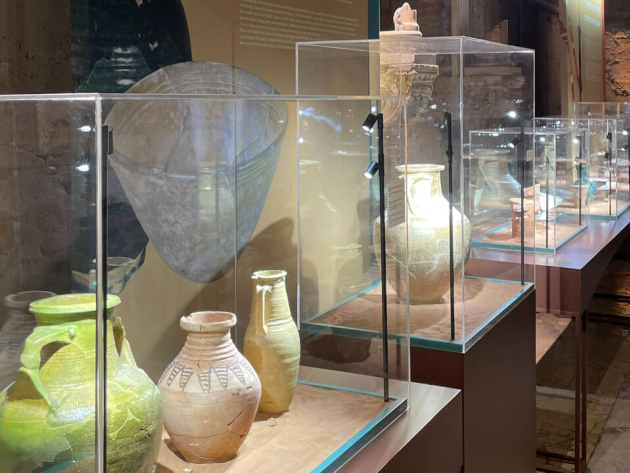
The exhibition which opens at the Curia Julia, inside the Colosseum archaeological Park, curated by Eisa Yousif and Francesca Boldrighini, illustrates to the public, for the first time in Italy, the extraordinary archaeological finds of the Emirate of Sharjah: the cities of Mleiha and Dibba in particular, which flourished between the Hellenistic era and the first centuries of the Roman Empire, were located at the centre of the ancient caravan routes that connected India and China with the Mediterranean and with Rome.
The links between Arabia and the Mediterranean area are in fact ancient and do not only affect the eastern Mediterranean, but also Rome and Spain. With the conquests of Alexander the Great, Egypt and Mesopotamia became part of the Hellenistic world; the eastern Mediterranean then became part of the Roman Empire, which later extended, with Trajan, to Mesopotamia and Arabia.
The main theme of the current exhibition therefore presents the history of the mysterious world of the ancient Kingdom of Oman during the Hellenistic and Roman periods, called the Mleiha period (named after the city) (3rd century BC – 3rd century AD). Although Alexander's empire and the Hellenistic states did not come to put these lands under their control, the Gulf and the southeast side of the Arabian Peninsula were at the crossroads of trade on the Eurasian continent. Mleiha, in fact, constituted an important hub along the maritime Silk Road that connected the West, with Egypt, Rome and Greece, to the East, with Mesopotamia, India and Central Asia, up to China, encouraging the exchange not only of goods and precious goods, but also of men and ideas that enriched the culture, religion and worldview of the local population.
Among the luxury goods that reached Rome through the Oman peninsula, for example, there were spices and above all incense. Used for food, religious and medical purposes, spices were so in demand and appreciated that their importation was strictly regulated by the State, so much so that the Flavian emperors had a special warehouse built in the Roman Forum: the Horrea Piperataria, recently made fully accessible for visits at the conclusion of the archaeological excavation campaigns.
As evidence of these close cultural and commercial contacts between East and West, the wonderful objects found in necropolises and inhabited areas throughout the then known world are also on display: wine amphorae from Rhodes and Italy, containers from Mesopotamia and Persia; alabaster ointment jars from Arabia and glass from the eastern Mediterranean; ivory combs, Indian jewels and earrings of Hellenistic make; figurines of Aphrodite and dedications to the deity al-Lat; Indo-Greek and Roman coins, original and local imitation. Everything contributes to outlining the image of a society open to numerous and different influences, characterized by great variety and cultural richness.
Sharjah is currently one of the seven emirates that make up the federation of the United Arab Emirates. It is located in the central part of the Oman peninsula, with access from both the Arabian Gulf to the west and the Oman Sea to the east. Finds dating back to the Paleolithic period in various areas of the emirate of Sharjah testify to human settlement in the area, up to the Neolithic (9000-4000 BC), and to the Bronze Age (4000-1250 BC) and the Iron Age (1250-300 BC). In this period the domestication of the camel was attested in the area, as well as the creation of an irrigation system which allowed a rapid development of agriculture. At the Mleiha site, vast cemeteries were found with monumental tombs belonging to the most important members of the community, surrounded by more modest tombs. The tombs, dating back to the 3rd-early 1st century BC, were individual and varied in size based on the funerary objects housed.
The exhibition is created thanks to a collaboration between the Colosseum Archaeological Park and the Sharjah Archaeological Authority, promoted by His Highness Sheikh Dr. Sultan bin Al Qasimi, member of the Supreme Council and ruler of Sharjah.
Photo credits: courtesy of the Colosseum Archaeological Park official site
Informations
 Condividi
Condividi











































